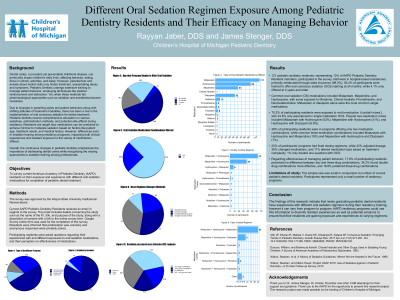Sedation
494 - Different Oral Sedation Regimen Exposure Among Pediatric Dentistry Residents and Their Efficacy on Managing Behavior


Rayyan M. Jaber, DDS
Resident
Children’s Hospital of Michigan -— Detroit Medical Center, Detroit, MI
Dearborn Heights, Michigan, United States- JS
James P. Stenger, DDS
Pediatric Dentistry Residency Program Director
Childrens Hospital of Michigan
Hazel Park, Michigan, United States - KP
Kristen Ponichter, DDS
Childrens Hospital of Michigan
Hazel Park, Michigan, United States
Presenting Author(s)
Research Mentor(s)
Program Director(s)
Purpose: The purpose of this research project is to gain a better understanding of AAPD residents’ experiences among different programs with different oral sedation medications and their perceived effectiveness at managing patient behavior.
Methods: A google form survey will be sent to current pediatric dental residents among AAPD Listserv. The anonymous survey consists of twelve questions regarding exposure to different types of oral sedation medications, number of types of medications administered during one sedation, and the participating resident’s opinion on what type of sedation mixture is most effective at managing patient behavior.
Results: 121 pediatric dentistry residents, representing 13% of AAPD Pediatric Dentistry Resident members, participated in the survey. Half were in hospital-based residencies, primarily reimbursed through state insurance (99.2%). 55.4% of participants were trained to offer oral conscious sedation (OCS) starting at 24 months, while 4.1% only offered at 4 years and older. Common oral sedation (OS) medications included Midazolam, Meperidine, and Hydroxyzine, with some exposed to morphine, chloral hydrate, promethazine, and dexmedetomidine. Midazolam or diazepam alone were the most common single medications. 75.2% of participating residents were exposed to multi-medication ('cocktail mixes'), with 24.8% only experienced in single medication OCS. Popular two-medication mixes included Midazolam with Hydroxyzine (52%), Meperidine with Hydroxyzine (31%), and Hydroxyzine with Diazepam (6.6%). 38% of participating residents were in programs offering only two medication combinations, while common three-medication combinations included Midazolam with Hydroxyzine and Meperidine (19%) and Meperidine with Hydroxyzine and Diazepam (7%). 22% of participants’ programs had fixed dosing regimens, while 32% adjusted dosage, 35% changed medications, and 11% altered medication type based on treatment complexity. 1% only treated one quadrant with OCS. Regarding effectiveness of managing patient behavior, 17.9% of participating residents perceived no difference between two and three-drug combinations, 34.2% found double drug combinations more effective, and 18.8% preferred three-drug combinations.
Limitations of study: The sample size was small in comparison to number of current pediatric dental residents. Participants represented only a small number of residency programs.
Conclusion: The findings of this research indicate that newly graduating pediatric dental residents have experiences with different oral sedation regimens during their residency training; however it can vary from program to program. AAPD residency programs could use this information to diversify resident experiences as well as potential solutions to ensure that their residents are gaining exposure and experiences to varying regimens.

.jpg)